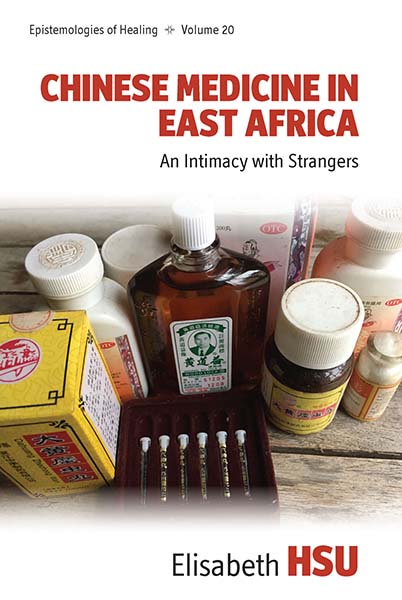Reviewed Book
Chinese Medicine in East Africa: An Intimacy with Strangers By Elisabeth Hsu, New York: Berghahn, 2022. pp. 440.

Yidong Gong
New College of Florida
There is a growing collection of ethnographies documenting China’s engagement with Africa. Yet despite these rich qualitative resources, we know little of the medical encounters between China and Africa. In the 1960s, China started sending medical teams to the newly independent African countries and became involved in the medical landscape of Africa following the discourse of “the poor helping the poor” (Snow 1988, 144). Beginning in the 1990s, this development ushered in new directions as private businesses from China made inroads into Africa. Elisabeth Hsu’s Chinese Medicine in East Africa: An Intimacy with Strangers is a much-needed ethnography that captures this important moment. Based on fieldwork conducted in the urban areas of Tanzania, Uganda, and Kenya, from 2001 to 2008, Hsu revisits her ethnographic materials and incorporates fresh theoretical perspectives.
“Chinese medicine,” in this book, transcends the common definition of traditional Chinese medicine (zhongyi,中医). Dawa ya Kichina (“China’s medicine” or “medicine from China”) refers to an assemblage of medicines and practices, including Chinese formula medicines (zhongchengyao, 中成药), medicine practiced by Chinese physicians, Chinese medical pharmaceuticals, or Chinese-manufactured Western biomedical pharmaceuticals. Chinese physicians are certainly “strangers” to East African patients, but their practice also fits into za kienyeji, “things of our place,” thus breaking the boundaries between the two sides. Hsu rejects a framework of ethnomedicine that often ends up in the discussion of hybridity, superdiversity, and creolization with “cultures” as the point of departure. Rather, this book emphasizes the “cultural efforts” of healing, which works on “a technique of transformation, a becoming part of a place, and an orientation towards the world” (372). Therefore, Hsu understands Chinese medicine in East Africa as a process of spatial texturing that involves the concerted efforts of patients, physicians, and materiality—or “pots,” in her words. All of this contributes to a sense of “wholeness” (3) in the practice of Chinese medicine.
Hsu’s analysis of the negotiation of materialities is particularly compelling. Taking a gestalt and ontological approach to medicine, Hsu perceives pots not only as objective materials but also as a propensity for “becoming into the space.” What matters is not only patient-physician interactions but also the intertwined relationship between craftsmanship, materiality, practice, techniques, and the body. Here, Hsu refrains from discussing Chinese medicine along the lines of rituals and morality but rather shifts to the material aspects of these social relations in detail. For example, she examines the packaging and marketing of Chinese formula medicines: the sound, ecological knowledge, folklore, and colors all play a role in convincing African patients that Chinese medicine is effective.
The richest ethnographic materials are in parts II and III, when Hsu investigates the people and materialities in relation to Chinese medicine. Many patients attracted to Chinese medicine are enterprising individuals, who can be loosely categorized as the “middle class.” In a similar vein, most physicians from China are petty entrepreneurs who have the adventurous spirt of explorers. Chapter 8, for example, focuses on how East African patients experience the materiality of Chinese formula medicine, speaking to the central question of efficacy in medical anthropology. Hsu frames the process as “a nexus of technique, matter and metaphor that affects an intersubjective, bodily felt sensory dimension” (257), rather than the placebo effect and “magic” treatment that are often associated with traditional medicine. However, expanding her attention beyond potency- and fecundity-enhancing Chinese formula medicines would have enriched the scope of Hsu’s analysis.
Hsu provides an impressively detailed account of her research methods, including mapping the field, language learning, semi-structured interviews, working with narratives, documenting the historical dimension, and reflecting on one’s mistakes, all of which are imbued into the chapters. However, the book does not follow a consistent analytical framework, and Hsu’s fieldwork data do not always support her arguments. For example, when she discusses the spaces of Chinese medical practitioners, she frames it as “rigorous standardization” that involves a table for diagnosis and a bed for treatment, thus acknowledging the doctors’ authority over the patients’ bodies. This description may give the impression that Chinese medicine is practiced in an essentialized form, which would contradict her argument that fluidity and intersubjectivity shape the practice. Moreover, Hsu’s analysis would have been enriched with more background information for the patients with whom she worked to provide much-needed ethnographic detail on her interlocutors’ lives. Another issue with this book is that it includes an excessive amount of subtitles for theoretical discussion, which sometimes are repetitive and redundant.
Despite these limitations, this book offers an important contribution to the ongoing discussions on China-Africa relations that are increasingly focused on the exchange of materials and ideas. The book will be of interest to scholars working on ethnomedicine and global health.
Reference
Snow, Philip. 1988. The Star Raft: China’s Encounter with Africa. London: Weidenfeld and Nicolson.